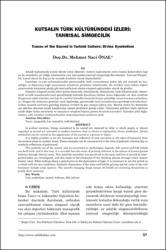Kutsalın Türk kültüründeki izleri: Tanrısal simgecilik
Abstract
Arkaik toplumlarda kutsal olarak kabul edilenler, modern toplumlarda yerini kutsal kabul edilen kişi ya da nesnelerin yer aldığı anlatmalara yani tanrısaldan tanrısal simgeciliğe devretmiştir. Tanrısal Simgecilik, kutsal olanın bir kişi ya da nesnede tezahürü olarak düşünülebilir. İnsanlığın en eski anlatmalarından günümüzdeki halk inanmalarına kadar pek çok metinde bu kutsallığın ve düşünceye bağlı yansımanın örneklerle görülmesi mümkündür. Bu örnekler tanrı-hakan ilişkisi çerçevesinde karşımıza çıktığı gibi tanrısal/kutsal olanın simgesel çağrışımları olarak da görülür. Kutsalın simgesel olarak erkin kullanılmasında, mitolojilerde, destanlarda, halk hikâyelerinde, efsanelerde ve halk inançlarında nasıl gerçekleştiği üzerinde durulmuş, böylece insan doğasında var olan yüceltme duygusuna edebî metinler aracılığı ile nasıl bir kutsallık kazandırılmaya çalışıldığı ortaya konmaya çalışılmıştır. Simgeci bir anlatımın geçmişte nasıl algılandığı, günümüzde nasıl yorumlanması gerektiği üzerinde durulurken insanlık tarihinin geçirdiği düşünce evreleri de gün yüzüne çıkmış olur. Mantık öncesi bir dönemden söz ederken dönemin kendi koşullarının toptan görülmesi gereği vardır. Günümüze gelirken sözlü edebiyat içinde değer bulan metinlerin ve inançların simgesel boyutu gizemi de içinde barındırır. Kutsalın şekil değiştirmesi, eski inançları yenileyip kendini meşrulaştırması anlamına gelir. In archaic societies, things considered to be sacred are replaced by tales in which people or objects regarded as sacred are narrated in modern societies; that is, divine is replaced by divine symbolism. Divine symbolism can be viewed as the appearance of the sacred as a person or object. It is highly possible to see the examples and reflection of such narration in the tales of humanity from the ancient times to modern times. These examples can be encountered in the form of god/ruler relationship or symbolic reflections of god/sacred. The symbolic use of the sacred, and its occurrence in mythologies, legends, folk stories and folk beliefs are dealt with, and in this way, it is revealed how the sense of praising inherent in the nature of human gained holiness through literary texts. How symbolic narration was perceived in the past, and how it should be interpreted today are investigated, and this leads to the elicitation of the thinking phases through which human history went. While talking about a period prior to the domination of logic, it is necessary to see the period as a whole with its own conditions. Symbolic dimensions of the texts and beliefs gaining special value in the oral literature include some mystery. The sacred& #8217; s changing shape means old beliefs are renewing themselves to justify their existence.


















